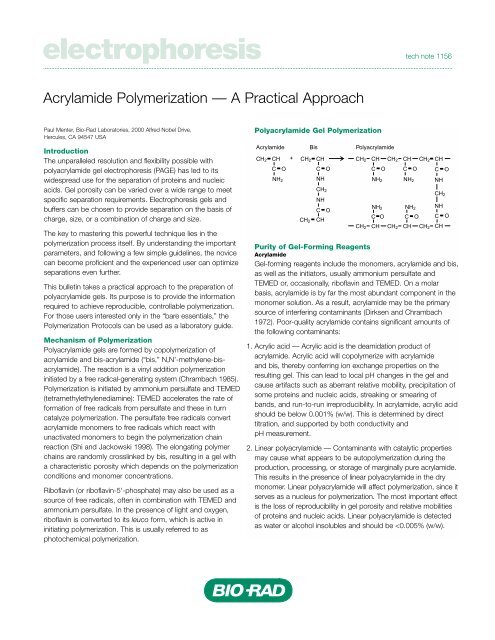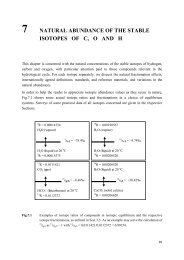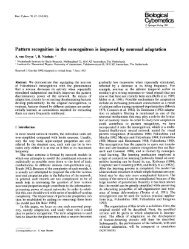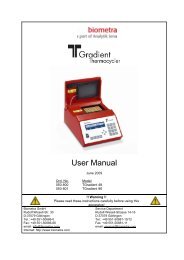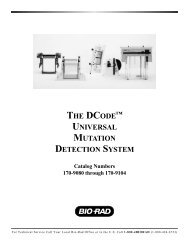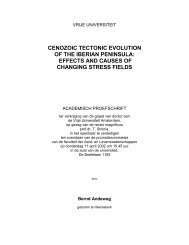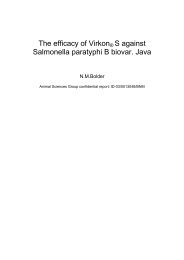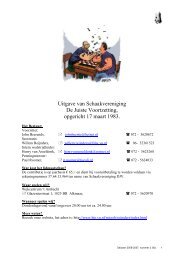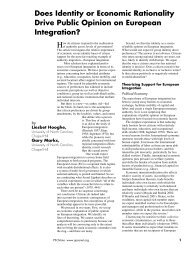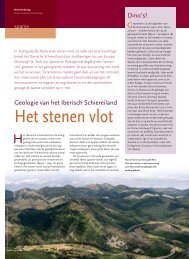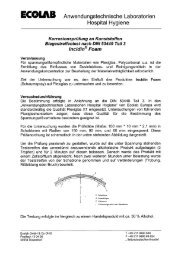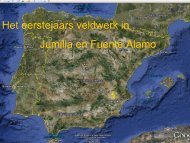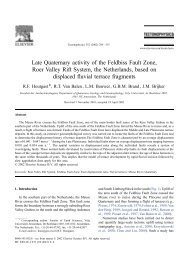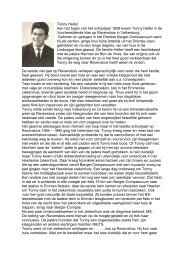Acrylamide Polymerization - Bio-Rad
Acrylamide Polymerization - Bio-Rad
Acrylamide Polymerization - Bio-Rad
Create successful ePaper yourself
Turn your PDF publications into a flip-book with our unique Google optimized e-Paper software.
This explains why polymerization initiated primarily by riboflavincan be completely blocked by exhaustive degassing. However,oxygen in excess of that needed to convert riboflavin to theactive form will inhibit polymer chain elongation, as it does inreactions initiated only by ammonium persulfate and TEMED.Thus, while degassing is still important for limiting inhibition,it must not be so extensive that it prevents conversion ofriboflavin to the active form. For polymerization initiated byriboflavin/TEMED, or riboflavin/TEMED/ammonium persulfatesystems, degassing should not exceed 5 min.A consequence of the interaction of riboflavin with oxygen isthat riboflavin seems to act as an oxygen scavenger. This issupported by the observation that the addition of riboflavin(5 µg/ml) to stacking gel solutions containing ammoniumpersulfate/TEMED initiators results in cleaner, more uniformpolymerization at gel surfaces exposed to oxygen (such ascombs). The same effect could likely be achieved by morethorough degassing of solutions without riboflavin.Whether using chemical polymerization (ammoniumpersulfate/TEMED) or photochemical polymerization(riboflavin/TEMED or riboflavin/TEMED/ammonium persulfateinitiators), reproducible gel quality and separationcharacteristics require careful attention to gel solutiontemperature before degassing, and to degassing time,temperature, and vacuum. These parameters should bekept constant every time gels are prepared.pHThe majority of electrophoresis systems are buffered atneutral or basic pH, at which the common initiators,ammonium persulfate, TEMED, and riboflavin, are effective.Riboflavin is the better choice for polymerization at low pH(Shi and Jackowski 1998); however, at low pH, TEMED maybecome protonated. This can result in slower polymerization,since the free base form of TEMED is required for initiation.For acidic buffer systems, alternative initiator systems aresometimes used (Andrews 1990).Alternative CrosslinkersPDA (piperazine di-acrylamide), a crosslinking agent that canbe substituted for bis in polyacrylamide gels, offers severaladvantages for electrophoresis. These include reducedbackground for silver staining, increased gel strength, andhigher-resolution gels. PDA can be substituted for bis on aweight basis without changing polymerization protocols.Crosslinkers other than bis and PDA may be used forspecialized purposes, the most common of which is gelsolubilization during post-electrophoresis recovery of proteinsor nucleic acids. These crosslinkers include DATD (diallyltartardiamide),DHEBA (dihydroxyethylene-bis-acrylamide),and BAC (bis-acrylylcystamine). Alternative crosslinkers maybe more or less reactive in polymerization than bis. Therefore,some adjustment in the concentration of initiators may benecessary to achieve optimal polymerization. For a discussionof alternative crosslinkers, see Gelfi and Righetti (1981b).Gel AdditivesThe most common gel additives include SDS (sodiumdodecyl sulfate), Triton* X-100 detergent, and chaotropicagents such as urea and formamide. Detergents can beadded to most common buffer systems without significantlyaffecting polymerization. Agents such as urea and formamide,however, cause the formation of smaller pore-size gels thanwould be formed in their absence (urea is often a componentof gel systems used to separate small proteins and peptides).This may be due to the disruption of hydrogen bondsbetween monomer molecules during polymerization. Smallerpore size may also be achieved at higher polymerizationtemperatures, an effect also attributed to hydrogen bonddisruption. Contaminants of gel additives can affectpolymerization. Nonionic additives such as urea, formamide,and Triton X-100 can be deionized with a mixed-bed ionexchange resin. Use 10 gm <strong>Bio</strong>-<strong>Rad</strong> Ag 5O1 X-8 resin per100 ml additive solution and let sit overnight. However,removal of nonionic contaminants from nonionic reagentsis not practical. Therefore, all additives should be qualityassuredfor electrophoresis.TimeAlthough visible gelation occurs in 15–20 min for chemicalpolymerization and 30–60 min for photochemicalpolymerization, polymerization continues much longer (seeFigure 1). Ammonium persulfate/TEMED-initiated reactionsshould be allowed to proceed for 2 hr to ensure maximumreproducibility in gel pore size. Photochemical polymerization(riboflavin-based initiator system) usually proceeds moreslowly than chemical polymerization, and is also dependenton light intensity (Shi and Jackowski 1998). However,riboflavin is usually used for polymerization of electrofocusinggels in which separation is based on charge, and for whichgel porosity is of secondary importance. Thus these gels canbe used shortly after visible gelation without being affected byslight variations in porosity.Monomer ConcentrationThe practical range for monomer concentration is between3%T and 30%T, where %T refers to % (w/v) of total monomer(acrylamide + bis) in solution. A higher concentration ofmonomer results in faster polymerization. Therefore, changingfrom 5% gels to 30% gels will probably allow a reduction of20–50% in the concentration of initiators.<strong>Polymerization</strong> ProtocolsThere are 2 major initiator formulations for acrylamidepolymerization. The first, for chemical polymerization, is usedfor SDS-PAGE and DNA sequencing. Chemical polymerizationemploys ammonium persulfate and TEMED as initiators.The second, for photochemical polymerization, is usedprimarily for horizontal electrofocusing gels. Photochemicalpolymerization calls for riboflavin as well as ammoniumpersulfate and TEMED. Riboflavin phosphate can besubstituted for riboflavin. Riboflavin phosphate is oftenpreferred for its greater solubility.
Preparation for <strong>Polymerization</strong>1. Prepare 10% ammonium persulfate shortly prior to use(prepare fresh daily). TEMED is used undiluted. Prepare0.1% riboflavin (or riboflavin phosphate, which is more soluble)if photopolymerization will be performed.2. Combine buffer stock solution, monomer stock solution,and water in the appropriate proportions in an Erlenmeyer flask.Since stock solutions are usually stored at 4°C, the gel solutionshould be allowed to warm to room temperature beforedegassing.3. Prepare the gel casting mold, i.e., plates, spacers, and clampsfor gel casting. Be sure they are neither hot nor cold.4. Once the gel solution is prepared and brought to roomtemperature (23–25°C), degas the solution under a vacuum of125 torr or better for 15 min at room temperature (for systemsin which constant agitation is used during degassing, 10 minis sufficient). Longer periods of degassing are generally notdeleterious, although long degassing will result in somewhatfaster polymerization.Chemical <strong>Polymerization</strong> in Discontinuous Systems— Lower (Resolving) GelIn a discontinuous system, such as that of Laemmli, theresolving gel is polymerized first. Then, the stacking gel is caston top of the resolving gel. Use the following protocol toprepare resolving gels for all discontinuous systems (seethe next section for preparation of stacking gels).Initiator volume per Initiator final10 ml gel solution concentrationAmmonium persulfate (10% w/v) 50 µl 0.05%TEMED (undiluted) 5 µl 0.05%Swirl the solution gently but thoroughly. Holding the flask bythe neck with one hand, swirl it 8 to 10 cycles. This mixesthe initiators completely without introducing too much oxygen.Swirling too little can result in uneven polymerization.Cast the gel by introducing the monomer solution into the gelmold in a steady stream to minimize the introduction of oxygen.Overlay the monomer solution using water, isoamyl alcohol,or water-saturated isobutyl alcohol to exclude oxygen fromthe surface.Allow polymerization to occur at room temperature at least90 min prior to use (see Figure 1).Chemical <strong>Polymerization</strong> in Continuous Systems andStacking GelsContinuous systems consist of a single gel. Continuoussystems are used for some types of protein electrophoresis,and for DNA sequencing. Stacking gels are part of discontinuoussystems. These gels have in common contact with thewell-forming comb and greater exposure to molecular oxygen atthe surface. Use the following levels of initiators for continuoussystems and stacking gels.Initiator volume per Initiator final10 ml gel solution concentrationAmmonium persulfate (10% w/v) 50 µl 0.05%TEMED (undiluted) 10 µl 0.1%Swirl the solution gently but thoroughly.Cast the gel and insert the well-forming comb without trappingair under the teeth.Allow polymerization to occur at room temperature at least90 min prior to use (see Figure 1).Photochemical <strong>Polymerization</strong>This protocol is recommended for isoelectric focusing(IEF) gels. Since molecules remain in the IEF gel duringelectrophoresis, excess ions from initiators can cause distortion ofbands. Photochemical initiation is recommended for IEF gelsbecause it is effective at low initiator concentrations.1. When the gel solution is prepared and brought to roomtemperature (23–25°C), degas the solution under a vacuum of125 torr or better for 2 min at room temperature (for systems inwhich constant agitation is used for degassing, 1 minis sufficient).2. Add initiators as follows:Initiator volume per Initiator final10 ml gel solution concentrationRiboflavin (0.1% w/v) 50 µl 0.0005%(5 µg/ml)Ammonium persulfae (10% w/v) 15 µl 0.015%TEMED (undiluted) 15 µl 0.05%3. Swirl the solution gently but thoroughly.4. Cast the gel and allow polymerization to occur for at least2 hr for isoelectric focusing gels. If separation is to be basedon size, allow photochemically initiated gels, to polymerizefor 8 hr under light from a nearby fluorescent lamp, (Righettiet al. 1981).


